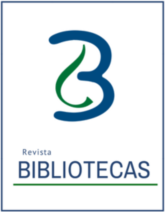Sustainable Digital Preservation Factors for Sound Archives
DOI:
https://doi.org/10.15359/rb.36-2.1Keywords:
Preservation, Digital Preservation, Sound Archives, SustainableAbstract
The preservation of digital documents is one of the most relevant challenges facing sound archives. The conservation and access to large volumes of digital sound information that is protected in sound archives is a complex task that requires a change of perspective in the traditional way of preserving sound documents. To face this challenge, it is proposed the sustainable digital preservation as the procedure to conserve and give access to the long-term sound content. The digital sustainable preservation takes in consideration three factors: a) shared technology infrastructure, b) reduce the consumption energy and the impact environmental and c) continuity and self-generation of economic resources.
References
Arquero, R. y Cobo, S. (2014). “Modelo de negocio y visión estratégica de Europeana”. En Ramos, L.; Arquero, R. Europeana. La plataforma del patrimonio cultural europeo. Ediciones TREA. España.
BBC Mundo. (2009). El costo ambiental de "googlear". BBC. Recuperado de http://news.bbc.co.uk/hi/spanish/science/newsid_7823000/7823918.stm
Blue Ribbon. (2008).The Blue Ribbon Task Force on Sustainable Digital Preservation and Access. Interim Report. Disponible en http://brtf.sdsc.edu/biblio/BRTF_Interim_Report.pdf
Bradley, K. (2007a). Defining digital sustainability. Library Trends, Volume 56 (1). Recuperado de http://muse.jhu.edu/journals/library_trends/toc/lib56.1.html
Bradley, K. (2007b). Hacia un sistema de almacenamiento y preservación en código abierto. Subcomité de tecnología del Programa Memoria del Mundo de la Unesco. Traducción al español Ing. Antonio Limas. CONACULTA, México.
Climate Group. (2008). SMART2020: enabling the low carbon economy in the information age. Recuperado de www.theclimategroup.org/publications/2008/6/19/smart2020-enabling- the-low-carbon-economy-in-the-information-age/
Chowdhury, G. (2012). Sustainability of digital information services, en Journal of Documentation, Vol. 69 (5). DOI http://dx.doi.org/10.1108/JD-08-2012-0104
Diccionario de la lengua española (2014). Última edición es la 23.ª Recuperado de http://lema.rae.es/drae/?val=sustentable
Edmondson, R. (2008). Filosofía y principios de los archivos audiovisuales. UNESCO.
Emerson Network. (2014). Data center 2025: exploring the possibilities, en Emerson Network Power. Recuperado de http://www.emersonnetworkpower.com/en-US/Latest-Thinking/Data-Center-2025/Pages/Data-Center-2025-Report.aspx
Fresa, A.; Justrell, B.; Prandoni, C. (2015). Digital curation and quality standards for memory institutions: PREFORMA research Project. Archival Science. DOI 10.1007/s10502-015-9242-8
IASA. (2005). IASA-TC 03 La salvaguarda del patrimonio sonoro: Ética, principios y estrategia de preservación. Versión traducida al español. México: IASA Radio Educación.
IASA. (2006). Lineamientos para la producción y preservación de objetos de audio digitales. TC-04. Asociación Internacional de Archivos Sonoros y Audiovisuales (IASA). UNESCO.
Informe Brundtland. (1987). Recuperado de http://www.un.org/es/comun/docs/?symbol=A/42/427
Jones, P.; Hillier, D.; Comfort, D.; Clarke-Hill, C. (2013) “Towards sustainable data centre operations in the UK”, en
Journal of Property Investment & Finance, 2013. DOI: 10.1108/1463578131129299
Lavoie, B. (2003). The Incentives to Preserve Digital Materials: Roles, Scenarios, and Economic Decision-Making. Reproduction, 45. Recuperado de http://www.oclc.org/research/projects/digipres/incentives-dp.pdf
Lavoie, B. (2004)."Of Mice and Memory: Economically Sustainable Preservation for the Twenty-first Century," en Access in the Future Tense. Washington, DC: Council on Library and Information Resources. Recuperado de http://www.clir.org/pubs/reports/pub126/lavoie.html
Miller, R. (2011).“How many Data Centers? Emerson says 500,000”. Data Center Knowledge. Recuperado de http://www.datacenterknowledge.com/archives/2011/12/14/how-many-data-centers-emerson-says-500000/
Nolin, J. (2010). Sustainable information and information science. Information Research-an International Electronic Journal.
Organización de Naciones Unidas (ONU). (2015). Convención Marco de Naciones Unidas sobre el Cambio Climático. Recuperado de https://unfccc.int/resource/docs/2015/cop21/spa/l09s.pdf
Rodríguez, P. (2016a). La preservación digital sustentable de archivos sonoros. México: Instituto de Investigaciones Bibliotecológicas y de la Información (UNAM).
Rodríguez, P. (2016b). La preservación digital sonora. Investigación Bibliotecológica: Archivonomía, Bibliotecología e Información, 68.
Romero, J. (2006). El papel de los metadatos en la preservación digital. El profesional de la información, 15 (2).
Ruusalepp, R. y Dobreva, M. (2013). Digital Preservation Services: State of the Art Analysis. European Commission, FP7. Recuperado de https://www.um.edu.mt/library/oar/bitstream/handle/123456789/311/dobreva_ Preservation_Services_study.pdf?sequence=1&isAllowed=y
Stroeker, N.; Panteia, R. (2012). Survey Report on Digitisation in European Cultural Heritage Institutions.
EUMERATE. ICT Policy Support Programme part of the Competitiveness and Innovation Framework Programme.
Tadic, L. (2015). The enviromental impact in digital preservation. Ponencia presentada en AMIA Conference, Portland, Estados Unidos.
TechTarget. (2012). Data center definition. Tech Target. Recuperado de http://searchdatacenter.techtarget.com/definition/data-center
Unión Europea. (2014). Conclusions on digital heritage as a strategic resource for a sustainable Europa. Education, Youth, Culture and Sport Council meeting Brussels.
UNESCO (1980). Recomendación sobre la Salvaguardia y la Conservación de las Imágenes en Movimiento: UNESCO. Recuperado de http://portal.unesco.org/es/ev.php
UNESCO (2003). Directrices para la preservación del patrimonio digital. UNESCO.
Térmens, M. (2013). Preservación digital. Editorial UOC. Barcelona, España.
Vilches, A; Macías, O. y Pérez, D. (2014). La transición a la sostenibilidad: un deafío urgente para la ciencia, la educación y la acción ciudadana. Organización de Estados Iberoamericanos.
Voutssás, J. (2009). Preservación del patrimonio documental digital en México. México. UNAM, Centro Universitario de Investigaciones Bibliotecológicas.
Walters, T., y Skinner, K. (2009). Economics, sustainability, and the cooperative model in digital preservation. Library Trends, 57(3). DOI: http://doi.org/10.1108/07378831011047668
Downloads
Published
How to Cite
Issue
Section
License
Bibliotecas provide immediate open access to their content, based on the principle of facilitating research to the public free of charge and free of charge to promote the global exchange of knowledge.
The journal Bibliotecas is a publication hosted by a public higher education institution, which is supported by public resources. Since its inception, the magazine has offered all its contents free of charge without any restriction on the rights of: reading, downloading and printing in full text. Works published in libraries may be analyzed, quoted and reproduced in whole or in part, mentioning the original source.
The journal Bibliotecas is licensed under the Creative Commons Attribution - Non-Commercial - Share Equal, 4.0 International license; therefore, it is allowed to: share, copy and redistribute the material in any medium or format.

Este obra está bajo una licencia Creative Commons Atribución-NoComercial-CompartirIgual 4.0 Internacional.








